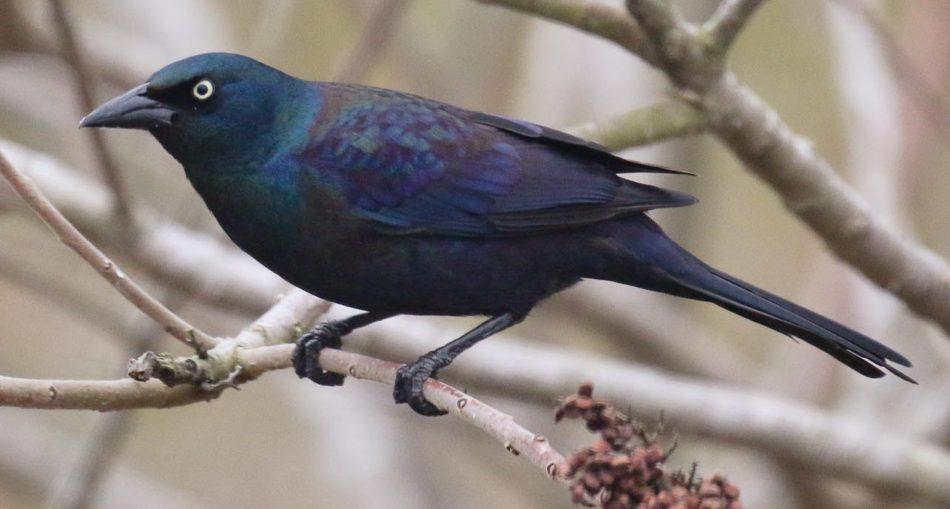This fierce-looking blackbird can often be seen hopping on the ground or sometimes swooping down to perch on the branch of a tree as they stalk their prey. For a long time, I assumed that these birds were crows, but do not make the same mistake as me, these beautiful, glossy black birds are known as ‘Grackles’. Here is everything you need to know about these common blackbirds.
Scientific Classification
Kingdom: Animalia
Phylum: Chordata
Class: Aves
Order: Passeriformes
Family: Icteridae
Genus: Quiscalus
Species: Q. Quiscula
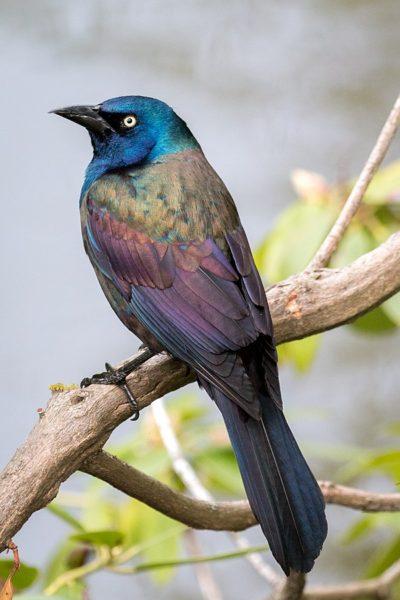
Photo of a common grackle. Photo Source: https://commons.wikimedia.org/wiki/File:Common_Grackle_-33_100-_%2833973682813%29.jpg
Description
Length – 28 to 34 cm (11 to 13 in)
Wing Span– 36–46 cm (14–18 in)
Average weight – 74–142 g
Common Grackles are blackbirds that look like they’ve been slightly stretched. They’re taller and longer-tailed than a typical blackbird, with a longer, more tapered bill and glossy-iridescent bodies. Grackles walk around lawns and fields on their long legs or gather in noisy groups high in trees, typically evergreens. They eat many crops (notable corn) and nearly anything else as well, including garbage. In-flight their long tails trail behind them, sometimes folded down the middle into a shallow V shape. Females are smaller and duller than males.
Habitat
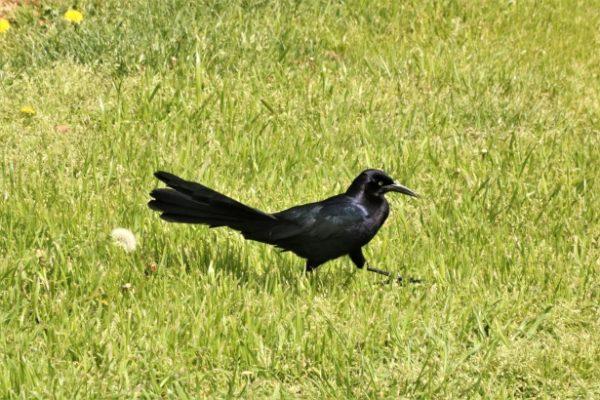
Photo of Grackle in grasslands. Photo Source: https://www.publicdomainpictures.net/en/view-image.php?image=290767&picture=great-tailed-grackle-in-grass
Common Grackles thrive around agricultural fields, feedlots, city parks, and suburban lawns. They’re also common in open habitats including woodland, forest edges, meadows, and marshes.
Communication
Both songs and body signals are used by common grackles to communicate. Each common grackle has a distinctive song that sets it apart from the others and may be used to identify a particular bird. According to some folks, the songs of common grackles have the sound of a rusty gate opening and closing. Males sing more frequently during copulation and less frequently during incubation and they sing more frequently than females do.
Here is a video of a Common Grackle sound – https://www.youtube.com/watch?v=4q6pRUHZ2nw
Reproduction
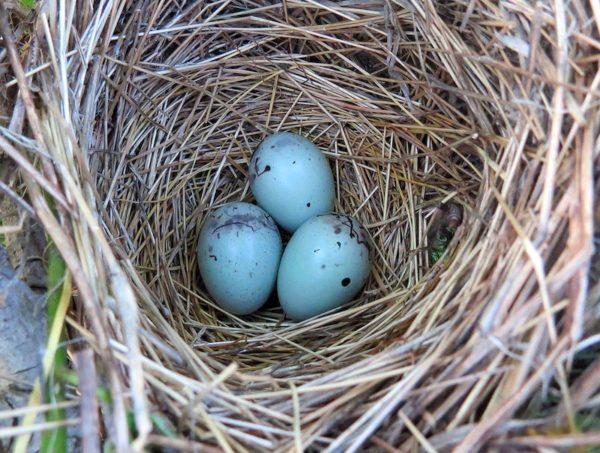
Photo of Grackle nest and eggs. Photo source: https://www.rawpixel.com/search/nest?page=1&sort=curated
Males and females would fly together forming a suitable breeding pair. The Female would choose a nesting area so she could start making her nest. Nests are often large and bulky, after the nest is completed copulation would begin. Five to six eggs are usually laid and then they go through an incubation period which lasts 12 to 14 days. Most females raise their chicks alone. Chicks leave their nests 12 to 15 days after they are hatched.
Behaviour
The common grackle is a quite social bird; if other birds are experiencing incubation then they would all huddle and sleep together.
Grackles would sometimes consume the eggs or nestlings of other birds. They would even kill and eat adult birds such as the house sparrow. They would attack other grackles by biting and scratching.
Diet
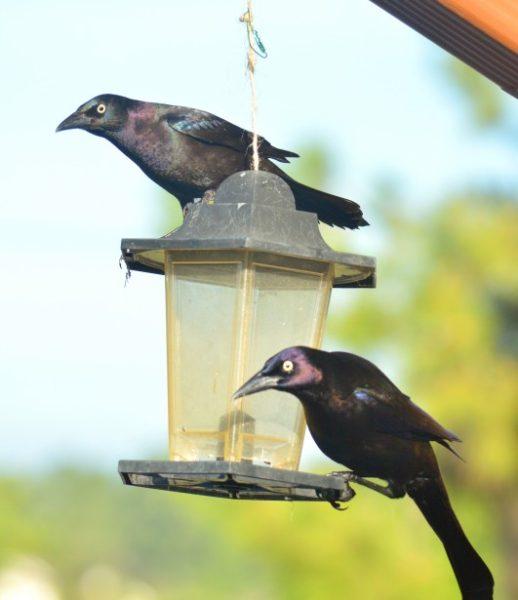
Photo showing Grackles feeding on seeds. Photo Source: https://www.publicdomainpictures.net/en/view-image.php?image=72493&picture=grackles-blackbirds-bird-feeder
The grackles’ diet comprises insects and other invertebrates, small frogs, mice, small bats that they capture while flying in the sky, and salamanders. They can also be found foraging in fields eating seeds, fruits, grains, and nuts. Due to deforestation, they had to evolve to withstand their changing environment by eating any food that they can find such as human garbage.
Fun Facts:
- They help to control the insect population.
- They disperse seeds through their droppings.
Fun Facts:
- Grackles are often mistakenly identified as corvids, or members of the family including crows, ravens, jays, and magpies. In fact, despite their much longer bills, tails, and general shape, grackles are more closely associated with blackbirds. Like many other blackbird species, grackles are commonly found in urban environments. They thrive off of human leftovers and are extremely resourceful.
- You might see a Common Grackle hunched over on the ground, wings spread, letting ants crawl over its body and feathers. This is called anting, and grackles are frequent practitioners among the many bird species that do it. The ants secrete formic acid, the chemical in their stings, and this may rid the bird of parasites. In addition to ants, grackles have been seen using walnut juice, lemons and limes, marigold blossoms, chokecherries, and mothballs in a similar fashion.
- Grackles have a hard keel on the inside of the upper mandible that they use for sawing open acorns. Typically they score the outside of the narrow end, then bite the acorn open.
The Symbolism Of The Grackle
The Grackle represents intelligence. Contrary to popular belief, grackles are not corvids, as was already said. They meet the highest standards for corvid intelligence and problem-solving regardless, though. Grackles are known for “anting,” which is a cunning habit displayed by crows in which the bird extends its wings and permits ants to crawl on them in order to benefit from the anti-parasitic effects of the acids secreted by the ants.
Native American Mythology:
In one Native American myth, a beastly individual called “Big Man-Eater” is killed by the brothers of a woman whom he has been terrorizing. After he is slain, they toss his ashes into the air. His ashes transform into blackbirds that fly away.
Another myth explains how the coyote’s tail got its black tip. In this story, a group of blackbirds is singing, dancing, and flying through the sky when they encounter Coyote. Coyote asks if he can join the dance. The blackbirds agree and give him feathers to fly with. Throughout the story, the blackbirds teach Coyote to fly but become increasingly impatient with his inability to keep up. Eventually, the blackbirds give up on Coyote and allow him to fall from the sky. His feathers shrivel up into the black hairs on the end of coyotes’ tails.
The grackle is a fascinating bird, whether it be an unattractive annoyance or a clever little contributor to the ecosystems of urban and suburban areas. The grackle is an animal that can teach us a great deal about living bravely and honestly. They are known for their boldness, ingenuity, resourcefulness, and brashness. The next time you’re outside try looking for a grackle or two and admire their genius and striking black feathers.
References:
- https://en.wikipedia.org/wiki/Common_grackle
- https://www.thingsguyana.com/the-sacred-heart-church-the-gem-of-main-street/
- https://www.allaboutbirds.org/guide/Common_Grackle/overview#
- http://www.biokids.umich.edu/critters/Quiscalus_quiscula/#:~:text=Common%20grackles%20use%20body%20signals,helps%20to%20identify%20that%20individual.
- https://worldbirds.com/grackle-symbolism/
Discover more from Things Guyana
Subscribe to get the latest posts sent to your email.

